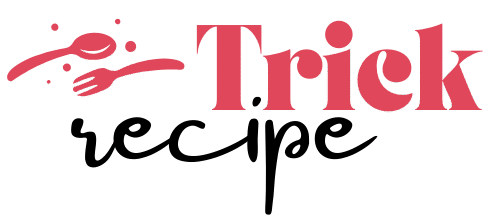Eating healthy doesn’t have to be boring, especially when you can whip up a high protein dense bean salad that’s delicious, satisfying, and packed with nutrients. Whether you’re vegan, vegetarian, or just trying to reduce your meat intake, a well-crafted high protein dense bean salad can fuel your body with plant-based protein, fiber, and essential vitamins. In this guide, we’ll explore the best beans to use, how much protein they actually deliver, step-by-step recipes, and smart ways to personalize your bowl.
Let’s dive into the first part—understanding what exactly makes these salads so protein-rich and why they deserve a place in your weekly meal prep.
Table of content
Table of Contents
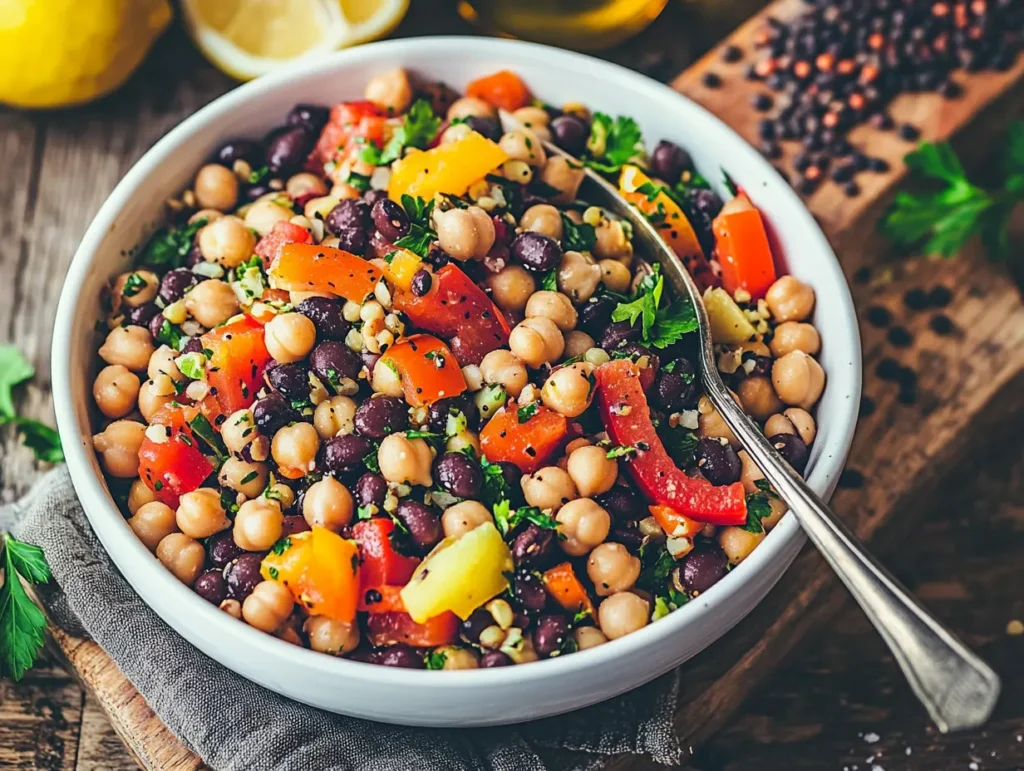
Understanding What Makes a high protein dense bean salad
What is a high-protein dense bean salad?
A high protein dense bean salad is more than just a colorful bowl of beans and veggies. It’s a nutritionally strategic meal built around legumes that deliver at least 10 grams of protein per cup, combined with other protein-rich ingredients like seeds, tofu, and lentils. The “dense” part refers to both protein content and nutrient value—this isn’t just a side dish, it’s a complete, satiating meal.
Unlike a leafy green salad that might leave you hungry in an hour, these hearty bowls keep you full longer. They’re designed to support everything from muscle repair to blood sugar balance, without needing animal protein.
Why are beans considered a top plant-based protein source?
Beans are a powerhouse in the plant-based world. Most varieties, including black beans, chickpeas, and kidney beans, offer 12–18 grams of protein per cooked cup. They also bring:
- High fiber content (important for digestion and satiety)
- Complex carbs (for sustained energy)
- Micronutrients like iron, magnesium, and potassium
Because they’re affordable and versatile, beans are a smart way to meet your daily protein goals, especially when paired with other complementary foods like grains or seeds to create a more complete amino acid profile.
Top High-Protein Beans to Include in Your Salad
Print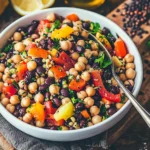
High Protein Dense Bean Salad – Best 30g+ Plant Meal
- Total Time: 15 minutes
- Yield: 4 Bowl
Description
This high protein dense bean salad is a hearty, plant-based recipe packed with over 30g of protein per serving. Made with a mix of black beans, lentils, chickpeas, tofu, and fresh vegetables, it’s perfect for meal prep, weight management, or clean eating. Refreshing, satisfying, and easy to customize, this salad is a go-to for vegans and protein lovers alike.
Ingredients
- 1 cup lentils
- 1 cup black beans
- 1 cup chickpeas
- ½ cup tofu, ½ red onion
- 1 red bell pepper1 carrot
- ½ cucumber, parsley, cilantro
- 2 tbsp pumpkin seeds
- 1 tbsp olive oil, lemon juice, Dijon mustard
Instructions
Rinse and prep all beans and tofu.
Chop vegetables and herbs.
Whisk dressing ingredients.
Combine everything in a large bowl.
Chill for 30 minutes before serving.
Notes: Vegan, gluten-free, high fiber, ideal for meal prep.
- Prep Time: 15 minutes
- Category: High Protein Meals
- Cuisine: Mediterranean / American Fusion
List of the Highest-Protein Beans Ranked
Not all beans are created equal when it comes to protein. To build a truly high protein dense bean salad, you’ll want to choose beans that offer the most bang for your buck—nutritionally speaking.
Here’s a ranked list of the best high-protein beans per 1-cup (cooked) serving:
| Bean Type | Protein (grams) | Calories |
|---|---|---|
| Soybeans (edamame) | 29g | 298 |
| Lentils | 18g | 230 |
| Black Beans | 15g | 227 |
| Kidney Beans | 13g | 225 |
| Pinto Beans | 15g | 245 |
| Chickpeas (Garbanzo) | 14.5g | 269 |
| Navy Beans | 15g | 255 |
| Lima Beans | 12g | 216 |
| Green Peas | 9g | 134 |
As you can see, soybeans, lentils, and black beans dominate the list. For even better amino acid balance, consider combining two or more types.
Learn more about the 3 ingredient banana weight loss recipe for another powerful plant-based option.
Nutritional Breakdown of Each Bean Type
Soybeans (Edamame)
- Rich in complete protein
- Contains all essential amino acids
- Great in both warm and cold salads
Lentils
- Fast cooking and highly absorbent
- Loaded with iron, folate, and protein
- Ideal for texture contrast
Black Beans
- Creamy texture, mild flavor
- High in antioxidants
- Great for Mexican-style salads
Chickpeas
- Nutty flavor and firm texture
- Packs protein plus plenty of fiber
- Great with lemon-based dressings
Kidney Beans
- Slightly sweet and chewy
- Combine well with spicy and savory dressings
By choosing from this list and mixing in other protein-enhancing ingredients, you’re laying a powerful nutritional foundation for your salad.
Looking for inspiration? Try our breakdown on egg noodles high in protein and how to complement them with beans.
Building the Perfect Protein Dense Bean Salad
Balancing Macros: Protein, Carbs, Fiber
A truly satisfying high protein dense bean salad isn’t just about beans—it’s about balance. To keep you full and energized for hours, your salad should contain the following:
- Lean protein from beans, lentils, tofu, or edamame
- Complex carbohydrates like sweet corn, peas, or quinoa
- Healthy fats from olive oil, avocado, or seeds
- Fiber from vegetables, beans, and legumes
This macro combination helps slow digestion, regulate blood sugar, and provide long-lasting energy. It’s also perfect for active individuals or anyone trying to manage weight.
Most salads fail because they’re missing either enough protein or fat—leaving you hungry too soon. With a high protein dense bean salad, you hit all the marks.
Essential Ingredients Beyond Beans
To take your salad from “just okay” to extraordinary, build in layers of texture and flavor using:
- Fresh herbs (parsley, cilantro, basil) for brightness
- Crunchy vegetables (red onion, bell pepper, celery, cucumber)
- Toasted seeds or nuts for added protein and crunch
- Bold dressings like lemon-tahini, spicy mustard vinaigrette, or avocado-lime
The dressing is where flavor meets function. Opt for olive oil or tahini-based options to keep it heart-healthy. Don’t forget citrus juice or vinegar for acidity—it brightens everything up.
For a complete visual guide and recipe inspiration, check out this external resource on high-protein bean salad from The Balanced Nutritionist.
Benefits of Eating High Protein Dense Bean Salads
How high protein dense bean salad Support Weight Management
One of the standout benefits of a high protein dense bean salad is how it naturally supports weight control—without sacrificing flavor or fullness. Here’s why:
- High protein content: Protein promotes satiety, which helps reduce overall calorie intake.
- Rich in fiber: Beans are loaded with soluble and insoluble fiber that helps keep you full longer, slows digestion, and stabilizes blood sugar.
- Low glycemic index: Most beans have a low GI, preventing spikes and crashes that trigger cravings.
- Minimal processed ingredients: When you build it from scratch, you control exactly what goes in—no hidden sugars, sodium, or preservatives.
high protein dense bean salads also shine as a meal prep staple. They’re easy to portion, store well in the fridge, and taste better after marinating. That makes them a smart choice for anyone eating healthy on a schedule.
Role of Fiber and Antioxidants
Beyond protein, beans are packed with antioxidants and phytonutrients that support cellular repair, reduce inflammation, and boost heart health. Here’s how each element contributes:
| Nutrient | Function |
|---|---|
| Fiber | Supports digestion, lowers cholesterol |
| Folate | Important for DNA synthesis & brain health |
| Magnesium | Helps with muscle function & energy production |
| Potassium | Regulates fluid balance and blood pressure |
| Polyphenols | Fights oxidative stress and inflammation |
Eating more legumes has been associated with reduced risks of chronic illnesses like heart disease, diabetes, and certain cancers.
Plus, plant-based meals like this contribute to sustainability—an important perk if you care about environmental impact.
Ingredients for a High Protein Dense Bean Salad
Core Protein-Rich Ingredients (For 4 Servings)
Building a high protein dense bean salad starts with selecting the right ingredients. Here’s a recipe designed to deliver over 20 grams of plant-based protein per serving:
| Ingredient | Amount | Protein Content |
|---|---|---|
| Cooked Lentils | 1 cup | 18g |
| Black Beans (drained & rinsed) | 1 cup | 15g |
| Chickpeas (drained & rinsed) | 1 cup | 14.5g |
| Firm Tofu (cubed) | ½ cup | 10g |
| Pumpkin Seeds | 2 tbsp | 5g |
These ingredients form the foundation of your protein—they combine for a complete amino acid profile when eaten together.
Flavor Boosters and Textural Additions
Texture and flavor make this salad memorable. Here’s what to include:
- 1/2 Red onion, finely chopped (for crunch and bite)
- 1 Red bell pepper, diced (adds color and vitamin C)
- 1/2 Cucumber, chopped (cool and hydrating)
- 1 Carrot, shredded (natural sweetness and crunch)
- 1/4 cup Fresh parsley and cilantro, chopped (freshness)
- 1 tbsp Olive oil (healthy fats, enhances flavor)
- Juice of 1 lemon (brightens everything)
- 1 tsp Dijon mustard (adds tang and depth)
- Salt & black pepper, to taste
- Optional: Crushed red pepper flakes or smoked paprika for a kick
This mix not only adds crunch and freshness but also contributes key micronutrients like vitamin A, C, K, and potassium.
Step-by-Step Recipe for the Ultimate high protein dense bean salad
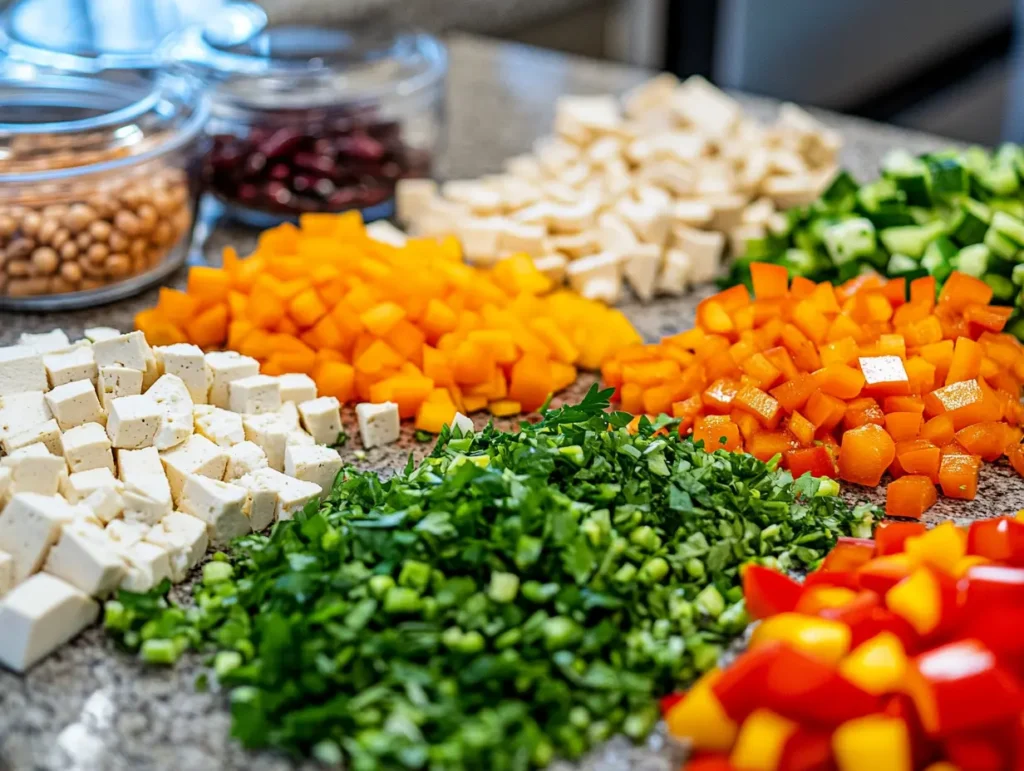
This high protein dense bean salad recipe is fast, flavorful, and designed to fit into any healthy lifestyle. Whether you’re meal prepping or serving guests, this salad delivers on both nutrition and taste.
Here’s how to make it in just 15 minutes:
Step 1: Prep the Protein-Rich Base
- Rinse and drain 1 cup each of black beans, chickpeas, and cooked lentils.
- Cut tofu into cubes (½ cup firm tofu). For extra flavor, sauté lightly in olive oil or air-fry until golden.
Tip: If using canned beans, rinse under cold water to reduce sodium and improve taste.
Step 2: Chop the Vegetables and Herbs
- Dice ½ red onion, 1 red bell pepper, and ½ cucumber.
- Grate 1 carrot finely.
- Chop ¼ cup each of fresh parsley and cilantro.
Place all chopped ingredients into a large mixing bowl.
Step 3: Make the Dressing
In a small bowl or jar, whisk together:
- 1 tbsp extra virgin olive oil
- Juice of 1 fresh lemon
- 1 tsp Dijon mustard
- 1 garlic clove, minced (optional)
- A pinch of sea salt and black pepper
- Optional: A pinch of smoked paprika or red pepper flakes for heat
Shake or whisk until fully emulsified.
Step 4: Combine Everything
- Add the beans, tofu, chopped veggies, and herbs into the bowl.
- Pour the dressing evenly over the top.
- Toss gently but thoroughly until everything is coated and colorful.
Step 5: Chill and Serve
- Refrigerate for at least 30 minutes before serving to allow flavors to meld.
- Garnish with 2 tbsp pumpkin seeds or your favorite seeds/nuts right before serving for crunch and added protein.
Bonus: This salad stays fresh for up to 4 days in an airtight container in the fridge—making it perfect for meal prep.
High protein dense bean salad for Special Diets
The beauty of a high protein dense bean salad is its incredible versatility—it fits almost every dietary lifestyle with just a few tweaks. Whether you’re plant-based, gluten-sensitive, or watching carbs, this recipe can work for you.
Vegan and Vegetarian Options
Good news: this salad is already 100% vegan and vegetarian by default. It uses:
- Legumes and lentils for complete protein
- Tofu for added texture and amino acids
- Plant-based dressings without eggs or dairy
Want to level it up even further?
- Swap tofu for tempeh (higher in protein and firmer)
- Use hummus as a creamy dressing base for a Mediterranean twist
For vegetarians who eat eggs or cheese:
- Add boiled eggs or crumbled feta for extra protein and flavor variety
Gluten-Free Modifications
Beans, tofu, and veggies are all naturally gluten-free. However, make sure to:
- Use certified gluten-free Dijon mustard (some brands add wheat derivatives)
- Avoid packaged spice blends that may contain hidden gluten or cross-contamination
If you’re serving this at a potluck, clearly label it gluten-free to prevent mix-ups.
Keto-Friendly Adjustments
While beans are relatively high in carbs, you can still make a lower-carb, high-protein bean salad with these smart swaps:
| Replace This | With This |
|---|---|
| Chickpeas | Firm tofu or tempeh |
| Lentils | Cooked edamame or seitan |
| Carrots | Zucchini or radish slices |
Focus on lower-carb legumes like edamame (soybeans), and balance them with high-fat additions like avocado and seeds.
A keto bean salad might include: tofu, edamame, cucumbers, avocado, olive oil, fresh herbs, and hemp seeds.
Comparing Bean Salad Protein to Animal-Based Options
Protein Per Gram: Beans vs. Chicken and Beef
Many people assume that plant-based proteins can’t match the muscle-building benefits of meat. But let’s look at the facts. Here’s how beans stack up against common animal proteins:
| Source (1 cup or 3 oz) | Protein (grams) | Calories |
|---|---|---|
| Grilled Chicken (3 oz) | 26g | 165 |
| Cooked Ground Beef (3 oz) | 22g | 250 |
| Cooked Lentils (1 cup) | 18g | 230 |
| Cooked Black Beans (1 cup) | 15g | 227 |
| Cooked Chickpeas (1 cup) | 14.5g | 269 |
Yes—meat has more protein per ounce.
But beans come with zero cholesterol, tons of fiber, and significant vitamins and minerals that meat lacks, such as folate and magnesium. They’re also far more heart-friendly and gut-supportive.
Combine beans with tofu, seeds, or whole grains and you’re closing the protein gap even more.
Digestibility and Amino Acid Profile
Animal proteins are complete—meaning they contain all 9 essential amino acids. Most beans are not complete by themselves. However, combining beans with grains, nuts, or seeds can easily fill those gaps.
Example combinations:
- Beans + quinoa = complete protein
- Chickpeas + tahini (hummus) = complete protein
- Lentils + sunflower seeds = nearly complete
Additionally, plant proteins are:
- Easier on the kidneys
- Lower in saturated fats
- More sustainable for the planet
If you’re worried about absorption, sprouting or fermenting beans (like in tempeh) can boost digestibility and nutrient bioavailability.
Delicious Variations and Add-Ins for Boosting Protein
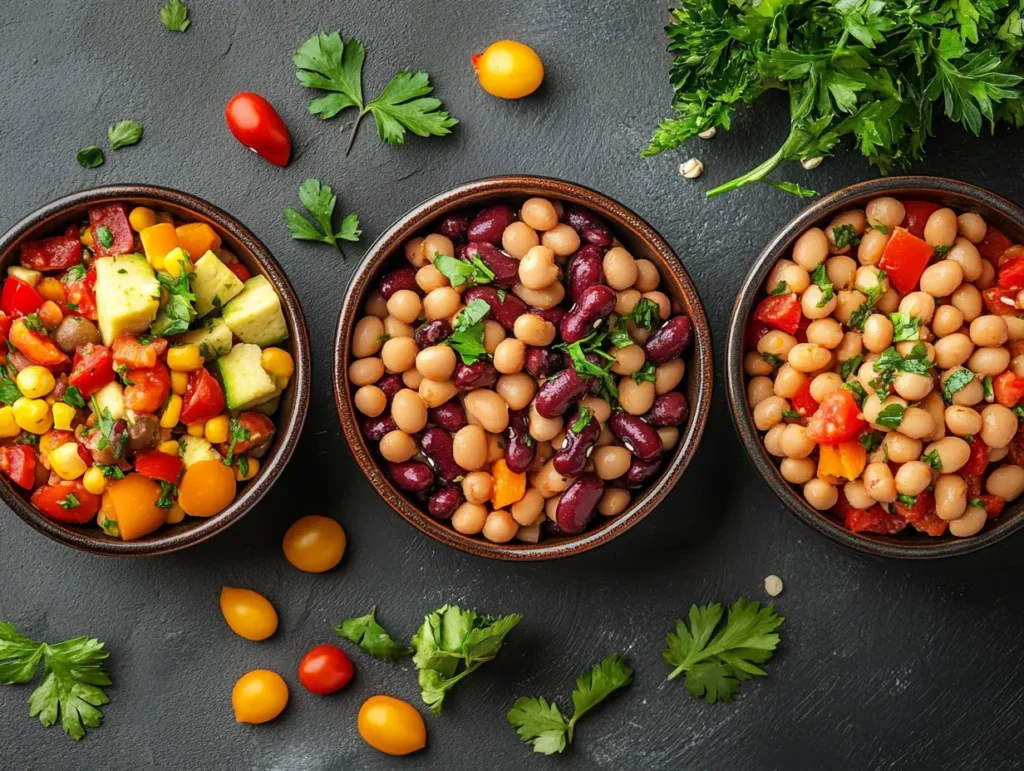
A high protein dense bean salad doesn’t have to be the same every week. The beauty of this dish is how easily you can customize it with flavor twists, global inspirations, and added protein.
Here are a few irresistible variations to keep your salad exciting—and even more protein-packed.
Add-Ins That Elevate Protein Content
Boost the total protein and texture with these powerhouse ingredients:
| Add-In | Amount | Protein (grams) |
|---|---|---|
| Cooked Quinoa | ½ cup | 8g |
| Hemp Seeds | 2 tbsp | 6g |
| Tempeh (cubed) | ½ cup | 15g |
| Boiled Eggs (sliced) | 1 whole | 6g |
| Greek Yogurt Dressing | 2 tbsp | 5g |
| Nutritional Yeast | 1 tbsp | 4g |
These additions don’t just boost the protein—they also bring new textures, flavors, and micronutrients.
Flavorful Bean Salad Variations
Try one of these three creative versions for your next meal prep:
1. Mediterranean Power Bean Salad
- Chickpeas, kidney beans, diced cucumber, kalamata olives, cherry tomatoes, red onion, parsley
- Dressing: Lemon juice, olive oil, oregano, garlic
- Optional: Add feta or quinoa for extra protein
2. Tex-Mex Protein Salad
- Black beans, corn, red bell pepper, avocado, green onions, chopped cilantro
- Dressing: Lime juice, cumin, olive oil, chili flakes
- Optional: Add cooked quinoa, crushed tortilla strips, or grilled tofu
3. Creamy Tofu Three-Bean Salad
- Edamame, lentils, white beans, tofu cubes, shredded carrots
- Dressing: Vegan yogurt, garlic, mustard, lemon juice
- Optional: Sprinkle with sunflower seeds or nutritional yeast for added crunch
Frequently Asked Questions About High Protein Dense Bean Salad
How much protein is in a dense bean salad?
The protein content in a dense bean salad varies based on the ingredients, but a well-balanced version with chickpeas, lentils, black beans, and tofu typically delivers 20–30 grams of protein per serving. For example, 1 cup of lentils has 18g, and adding ½ cup of tofu and seeds can push the total even higher.
Are dense bean salads actually healthy?
Yes—dense bean salads are incredibly healthy. They’re rich in plant-based protein, fiber, vitamins, and minerals, while being low in saturated fat and cholesterol-free. The combination of legumes and veggies makes them heart-healthy, gut-friendly, and great for managing blood sugar and weight.
What kind of beans are highest in protein?
The highest protein beans include:
Soybeans (Edamame) – 29g per cup
Lentils – 18g per cup
Black Beans – 15g per cup
Chickpeas – 14.5g per cup
Kidney Beans – 13g per cup
These varieties are ideal for building a protein-dense salad.
Is bean salad high in protein?
Yes, a well-prepared bean salad is high in protein, especially when combining multiple legumes like black beans, lentils, and chickpeas. Add-ins like tofu, quinoa, or seeds can boost the protein count significantly. It’s one of the best plant-based meal options for meeting daily protein needs.
Conclusion: Make High Protein Dense Bean Salad a Staple in Your Weekly Menu
A high protein dense bean salad isn’t just a trendy dish—it’s a smart, sustainable, and satisfying way to fuel your body. Packed with plant-based protein, fiber, and nutrients, it can easily replace traditional meat-heavy meals without skimping on flavor or fullness.
Whether you’re looking to build muscle, lose weight, or simply eat cleaner, this salad adapts to every lifestyle—vegan, gluten-free, or high-protein diets. With endless variations and easy meal prep, it’s the kind of dish you’ll actually look forward to eating again and again.
So grab your beans, chop your veggies, mix up a zesty dressing, and build a bowl that works as hard as you do.
